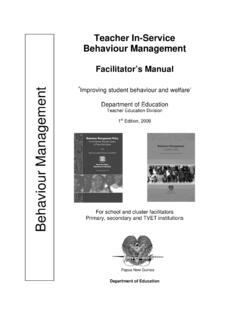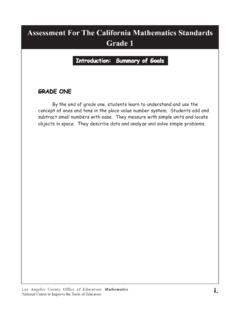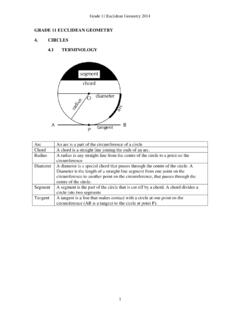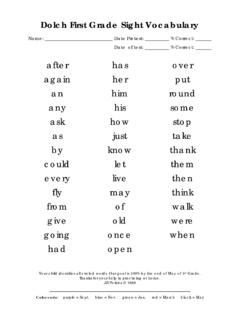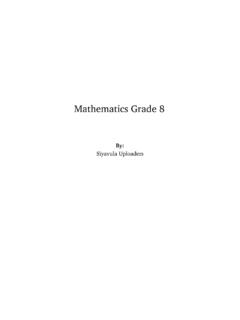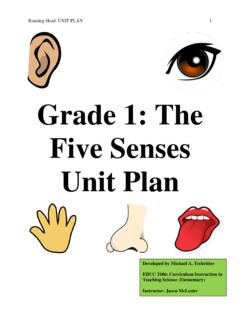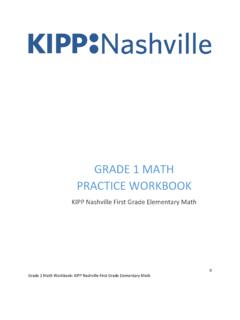Transcription of GRADE 11 GENERAL MATHEMATICS 11.1: NUMBERS AND …
1 DEPARTMENT OF EDUCATION GRADE 11 GENERAL MATHEMATICS : NUMBERS AND APPLICATIONS FODE DISTANCE LEARNING PUBLISHED BY FLEXIBLE OPEN AND DISTANCE EDUCATION FOR THE DEPARTMENT OF EDUCATION PAPUA NEW GUINEA 2017 GR 11 GENERAL MATHEMATICS M1 NUMBER AND APPLICATION 1 GRADE 11 GENERAL MATHEMATICS MODULE 1 NUMBERS AND APPLICATIONS TOPIC 1: BASIC NUMERACY TOPIC 2: LAWS OF INDICES TOPIC 3: SURDS TOPIC 4: UNITS OF MEASUREMENTS GR 11 GENERAL MATHEMATICS M1 ACKNOWLEDGEMENT 2 Flexible Open and Distance Education Papua New Guinea Published in 2017 @ Copyright 2017, Department of Education Papua New Guinea All rights reserved. No part of this publication may be reproduced, stored in a retrieval system, or transmitted in any form or by any means electronic, mechanical, photocopying, recording or any other form of reproduction by any process is allowed without the prior permission of the publisher.
2 ISBN 978 - 9980 - 89 - 341 - 3 National Library Services of Papua New Guinea Compiled and finalised by: MATHEMATICS Department-FODE Printed by the Flexible, Open and Distance EducationACKNOWLEDGEMENT We acknowledge the contributions of all Secondary Teachers who in one way or another have helped to develop this Course. Our profound gratitude goes to the former Principal of FODE, Mr. Demas Tongogo for leading FODE team towards this great achievement. Special thanks to the Staff of the English Department of FODE who played an active role in coordinating writing workshops, outsourcing lesson writing and editing processes, involving selected teachers of Central Province and NCD. We also acknowledge the professional guidance provided by Curriculum and Development Assessment Division throughout the processes of writing, and the services given by member of the English Review and Academic Committees.
3 The development of this book was Co-funded by GoPNG and World Bank. DIANA TEIT AKIS PRINCIPAL GR 11 GENERAL MATHEMATICS M1 CONTENTS 3 CONTENTS Title 1 Acknowledgement and Copy Right 2 Contents 3 Secretary s Message 4 Course Introduction 5 : BASIC NUMERACY Real NUMBERS 9 Factors and Multiples 28 Fractions, Decimals and Percentages 32 Significant Figures 48 Estimation and Error 52 Summative Task 50 : LAWS OF INDICES Basic Concepts 55 Index Laws of Multiplication 58 Index Laws of Division 61 The Rule for Zero as a Power and Negative Indices 64 Indicial Equations 70 Summative Task 71 3: SURDS Basic Concepts 73 Laws of Surds or Radicals 77 Addition and Subtraction of Surds 82 Multiplication of Surds 86 Division of Surds 91 Summative Task 96 4: UNITS OF MEASUREMENTS Measurement 100 Conversion of Metric and Imperial Units 104 Quadratic Equations 115 Inequalities 144 Summative Task 155 SUMMARY 149 ANSWERS TO LEARNING ACTIVITIES 160 REFERENCES 183 GR 11 GENERAL MATHEMATICS M1 MESSAGE 4 SECRETARY S MESSAGE Achieving a better future by individual students and their families, communities or the nation as a whole, depends on the kind of curriculum and the way it is delivered.
4 This course is a part of the new Flexible, Open and Distance Education curriculum. The learning outcomes are student-centred and allows for them to be demonstrated and assessed. It maintains the rationale, goals, aims and principles of the national curriculum and identifies the knowledge, skills, attitudes and values that students should achieve. This is a provision by Flexible, Open and Distance Education as an alternative pathway of formal education. The course promotes Papua New Guinea values and beliefs which are found in our Constitution, Government Policies and Reports. It is developed in line with the National Education Plan (2005 -2014) and addresses an increase in the number of school leavers affected by the lack of access into secondary and higher educational institutions.
5 Flexible, Open and Distance Education curriculum is guided by the Department of Education s Mission which is fivefold: To facilitate and promote the integral development of every individual To develop and encourage an education system satisfies the requirements of Papua New Guinea and its people To establish, preserve and improve standards of education throughout Papua New Guinea To make the benefits of such education available as widely as possible to all of the people To make the education accessible to the poor and physically, mentally and socially handicapped as well as to those who are educationally disadvantaged. The college is enhanced to provide alternative and comparable pathways for students and adults to complete their education through a one system, many pathways and same outcomes.
6 It is our vision that Papua New Guineans harness all appropriate and affordable technologies to pursue this program. I commend all those teachers, curriculum writers, university lecturers and many others who have contributed in developing this course. UKE KOMBRA, PhD Secretary for Education GR 11 GENERAL MATHEMATICS M1 BASIC NUMERACY 5 NUMBERS AND APPLICATIONS Introduction This Unit focuses on the MATHEMATICS used every day in our communities to measure, compare and present information numerically. There is an emphasis on the development of real NUMBERS and their everyday usage in learning MATHEMATICS . This is the first unit in the series of MATHEMATICS B for GRADE 11. As you go along with the unit, you will find lessons and activities which will help you make use of appropriate techniques and instruments to estimate and calculate physical quantities.
7 In addition, this unit will also lead you to apply knowledge of NUMBERS and their relationships to investigate a range of different context. : BASIC NUMERACY This topic introduces real NUMBERS in complex number field; and revises multiples and factors, operations with fractions, estimation and error, and writing digits correct to specified significant digits. : LAWS OF INDICES This topic revises basic concepts of indices, and laws of indices. The topic provides the basis to study logarithms and exponential functions and graphs. : SURDS This topic evolves from laws of indices; it expands on to application of basic operations on surds. It explains the approximation and exact values of quantities and measurements. : UNITS OF MEASUREMENTS The topic covers Metric and Imperial Measurement. Then expands on to quadratic equations and graphs.
8 It also discusses inequalities and systems of inequalities. You will also find that most of the lessons in this unit are revisions and continuations of the lessons you have learnt in your lower secondary MATHEMATICS . This serves as a springboard for the more challenging and more complicated units. It also gives you the time to master the skills needed for higher MATHEMATICS courses such as Trigonometry and Calculus. GR 11 GENERAL MATHEMATICS M1 INTRODUCTION 6 LEARNING OUTCOMES On successful completion of this module, you will be able to: discuss the historical development of real NUMBERS classify and relate symbols to all real NUMBERS plot real NUMBERS on the real number line apply the properties of real NUMBERS state the law or properties of surds. apply properties of surds simplify and rationalize surds state the number of significant figures round off significant figures apply the laws of indices express index NUMBERS in surds form write metric measurements of length, mass and capacity convert metric measurement to imperial or vice versa apply scales on actual lengths on the ground TIME FRAME This unit should be completed within 10 weeks.
9 If you set an average of 3 hours per day, you should be able to complete the unit comfortably by the end of the assigned week. Try to do all the learning activities and compare your answers with the ones provided at the end of the unit. If you do not get a particular exercise right in the first attempt, you should not get discouraged but instead, go back and attempt it again. If you still do not get it right after several attempts then you should seek help from your friend or even your tutor. Do not pass any question without solving it first. GR 11 GENERAL MATHEMATICS M1 BASIC NUMERACY 7 Basic Numeracy The term numeracy is similar to the word literacy. Just as the early definitions of the literacy have progressed from reading and writing , numeracy is more than NUMBERS and measurements . In the eighties, the British Cockroft Committee developed a definition of numeracy.
10 Cockroft Committee stated that a numerate person should understand some of the ways MATHEMATICS can be used for communication, and this required the possession of two attributes: 1. being at-ease with all those aspects of MATHEMATICS that enable a person to cope with the practical demands of everyday life, and 2. the ability to understand information presented in mathematical terms. Basic numeracy skills consist of comprehending fundamental MATHEMATICS like addition, subtraction, multiplication, and division. For example, if one can understand simple mathematical equations such as 2 + 2 = 4, then one would be considered possessing at least basic numeric knowledge. Substantial aspects of numeracy also include number sense, operation sense, computation, measurement, geometry, probability and statistics.





